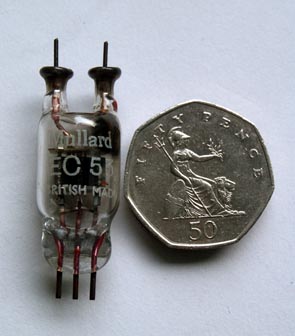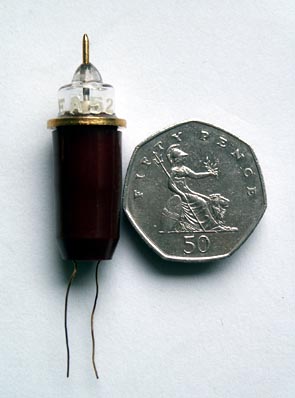
| The valves shown here were developed for special purposes, without exception to meet the demand for equipment operating at higher frequencies. Later, valves were produced to cram more into less space. Examples of these are not shown here yet but include sub-miniature valves for military applications and small domestic items such as deaf aids. |

|
This tiny valve is a type "954". There were a number of similar "Acorn" valves available after the war to amateur radio enthusiasts keen to open up the VHF bands, including the 955, 956, 957, 958 and 959. The last three were battery valves. Two 958s, if I recall correctly, were used in the BC1066 UHF receiver together with the exotic 1D8GT (a most complicated diode/triode/pentode squeezed onto an octal base). I made a number of super-regenerative receivers using the 955 and the 958 in the early 50s on which I heard, with great excitement, local air traffic control transmissions from Speke Airport (now "John Lennon Airport") in Liverpool. The 954 is an RF pentode and has a 6.3v, 150mA heater, and runs 250v and 100v on anode and screen respectively. Anode current is a scanty 2mA. The 956 was the variable mu version and the 955 a triode with similar ratings to the 956. The 957 and 958 were battery triodes with filament ratings of 50ma and 100mA at 1.25v and the 959 was a 50ma, 1.25v filament pentode. All proved useful up to 400MHz. The acorn valves were developed in the USA by RCA, from 1934 to 1938, in an attempt to make valves suitable for amplification at VHF. Because of their size they were fiddly to make and mass production, especially during the war in the UK, was fraught with problems. This example came from the Tungsram valve factory in Philadelphia. A series of "all-glass" similarly sized diode valves, of which the most well known being the EA50, were very common in WWII equipment (there are two in the R1392 shown on another page). These vied with the old Westector copper oxide rectifier, which had a slight edge in less demanding applications, in not requiring any heater current. Maybe readers of these jottings will know of other applications for these tiny little triode and pentode valves. Let me know and I'll add them to these paragraphs. Incidentally, the cardboard box measures 55mm x 33mm. The valve itself has a body diameter of 19mm and an overall length of 41mm. The last attempt, again by RCA, to make a VHF/UHF valve by reducing its physical size, before transistors took over, can be seen in the Nuvistor shown below. |

|
Propped up on the 50p are a couple of Nuvistors. These are metal clad thermionic valves which were available in various guises, such as triodes (these examples) or tetrodes etc. The valve, introduced by RCA in 1959 is claimed to be the smallest ever made. They have 6.3 volt heaters and have lower than normal HT requirements. Noise performance was excellent and has only been relatively recently been surpassed by transistors. The latter are now far superior to valves with noise figures typically of around 0.5dB at 12GHz but in the early days of transistors the nuvistor was the only real option if one wanted good performance at VHF and UHF. That is unless one wanted to spend pots of money on really exotic devices such as parametric amplifiers and the like. The 6CW4 being a triode was not too easy to use to obtain its maximum performance as it needed to be neutralised; that is to balance out internal feedback to prevent it oscillating. Not only was the nuvistor found in high performance VHF receivers it was also used in the popular Tektronix oscilloscopes of the 60s in their wideband Y amplifiers were it happily co-existed with transistors. |

|
This tiny valve, which as you can see was made by Mullard, uses this unusual construction to reduce the internal capacities between its electrodes and leads to attain a maximum working frequency of 600MHz. The anode and grid connections, which are brought out at the top of the valve are designed to assist in the layout of a UHF tuned circuit. HT is rated at 250 volts and a typical maximum anode current is 15mA. Operating at its maximum frequency requires somewhat less than these values as the efficiency of the valve drops off sharply as the frequency is raised. A figure of less than 10% efficiency, representing less than a fifth of a watt, at its maximum working frequency is all that can be expected, but at 2 metres though, one can expect almost a watt and a half. As the heater supply is 0.25 amps at 6.3 volts the overall efficiency on 2 meters is not that good. If the output is say 1.25 watts at 33% efficiency, the DC input will be 3.75 watts. Add to this the heater supply, say 1.6 watts and the overall efficiency is a little over 23%. Compare this with a decent UHF power transistor, say 70%, and one can see the benefits brought by transistors. When the EC53 was introduced transistors had not been invented and it took many years before those were made to work at anything other than up to 30MHz. |

|
|